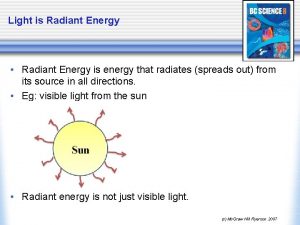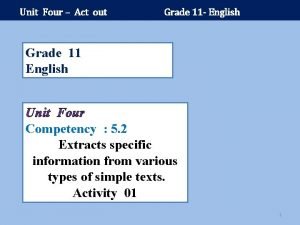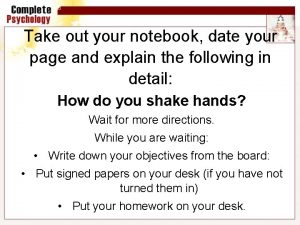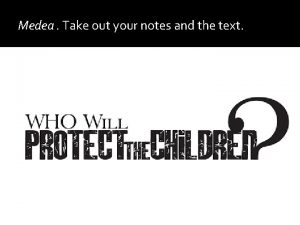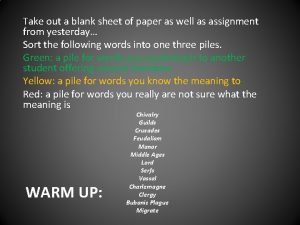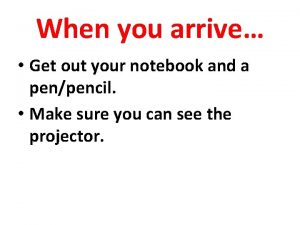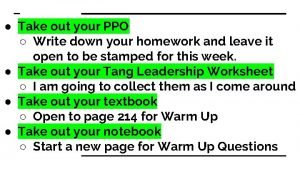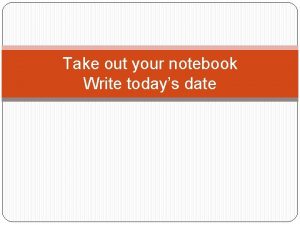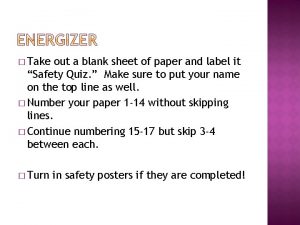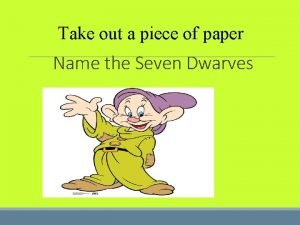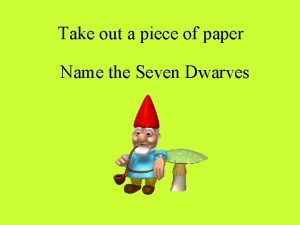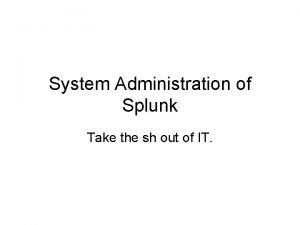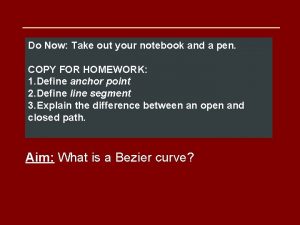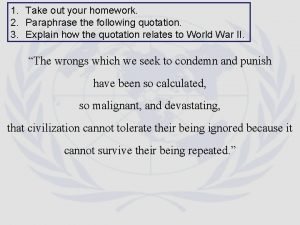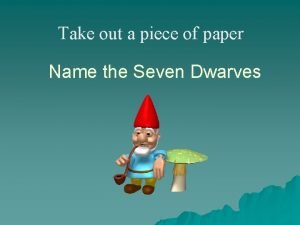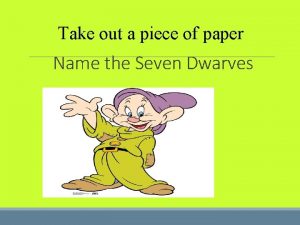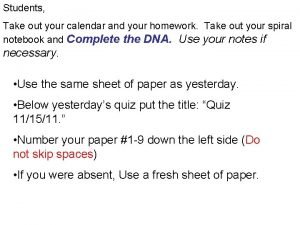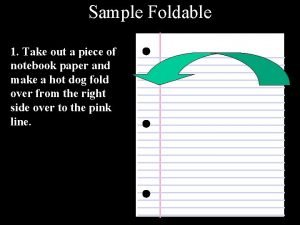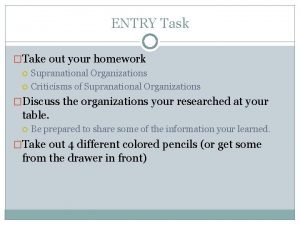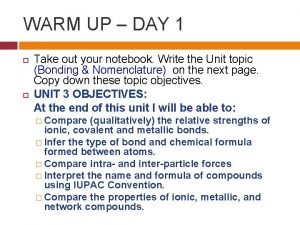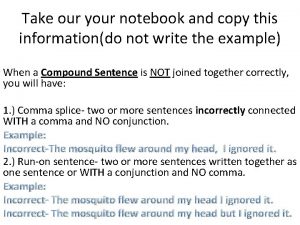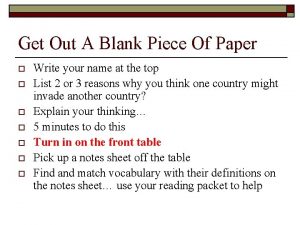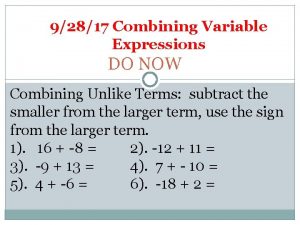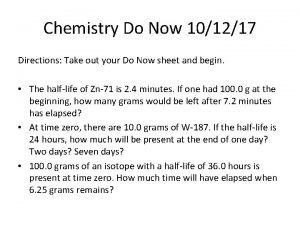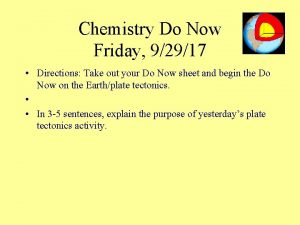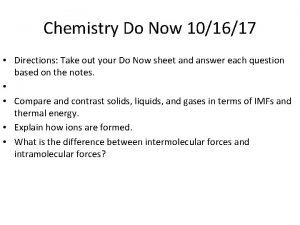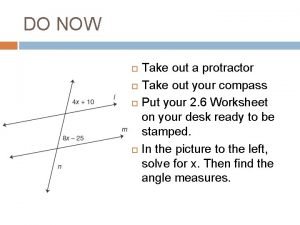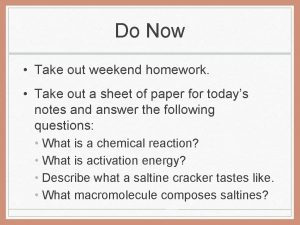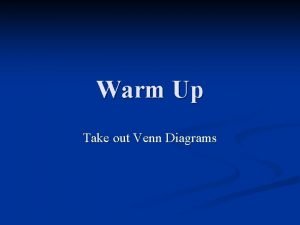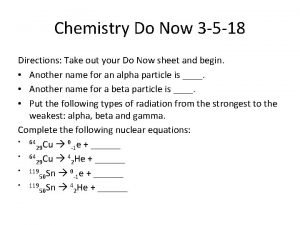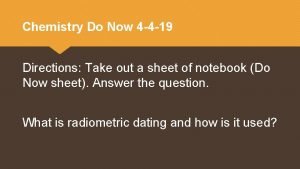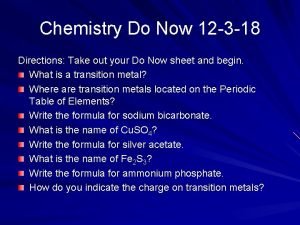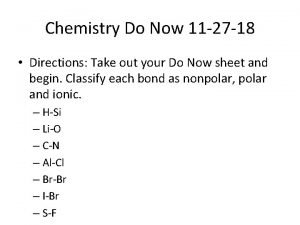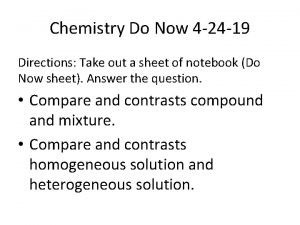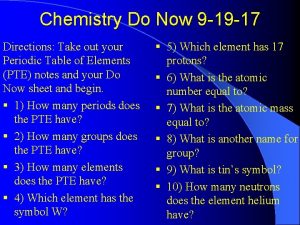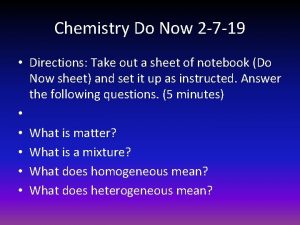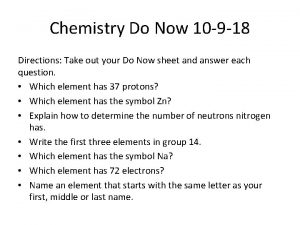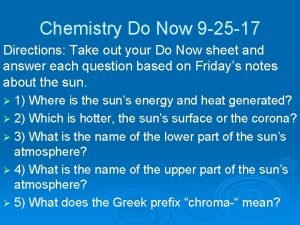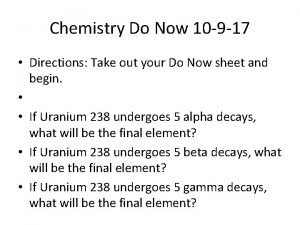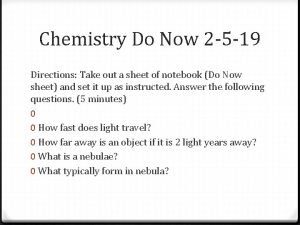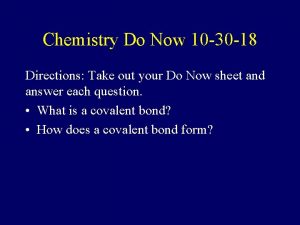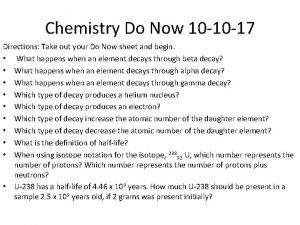Chemistry Do Now Thursday 92817 Directions Take out







































- Slides: 39

Chemistry Do Now Thursday, 9/28/17 Directions: Take out your Do Now sheet and begin the Do Now on the Earth. • Compare and contrast the two major types of crust. • What does the prefix lithos- mean? • What is a tectonic plate? • Explain why the faults along the Pacific Plate are called the “Ring of Fire”. • What does the prefix asthenes- mean? • Describe the layer of the Earth called the asthenosphere. • What happens to the pressure and temperature inside of the Earth as you move closer to the core?

Chemistry Do Now Thursday, 9/28/17 KEY • • Similarities: Both are made of rocky material, both form the outer part of the Earth. Similarities: Differences: Oceanic crust is denser and made of basalt rocks. Oceanic crust is beneath the Differences: world’s oceans. Continental crust is thicker and lighter than oceanic rock. It is made of granite rock and forms the world’s seven continents. What does the prefix lithos- mean? Rock or stone What is a tectonic plate? A piece of the lithosphere that is broken into large pieces Explain why the faults along the Pacific Plate are called the “Ring of Fire”. Along the “Ring of Fire” are lots of volcanoes and earthquakes. What does the prefix asthenes- mean? Soft or weak Describe the layer of the Earth called the asthenosphere. The asthenosphere is the upper region of the Earth’s mantle on which the lithospheric tectonic plates slides across. The asthenosphere oozes and moves very slowly almost like melted plastic. What happens to the pressure and temperature inside of the Earth as you move closer to the core? The closer to the Earth’s core one moves, the greater the Earth’s internal pressure and temperature get.

S/O’s & Reminders of Important Dates • Back to School Night was a success! Congrats to Breyawna Simmons, Dauisha Carlton, Nickolas Burney, William Portillo, Elijah Dorsey, Angel Franklin, and Keena’ Henderson for earning a bonus test grade of 100% for Henderson coming out to this event! • 1 st Quarter Progress report grades close on Wednesday, October 4, 2017. • If you are failing a class, you have 6 more days to improve your grade before progress report grades are finalized!

Homework • TO BE COLLECTED: Take out last night’s Close Read/DEJ on Plate Tectonics. Put it to the side at your desk. • TONIGHT’S HOMEWORK: Write a 6 -8 sentence summary about today’s notes.

Objective • Students will know the history of the Earth, plate tectonics and those factors (asteroids, comets, meteorites) that shaped the topography of the planet by performing a close reading, taking notes and answer exit ticket questions. • Mastery Level: 2/3 or better on the Exit Ticket questions

New Vocabulary Words • • Tectonic Plates Crust Mantle Core Lithosphere Asthenosphere Outer Core • • Mesosphere Inner Core Earthquake Tsunami Volcano Volcanic Eruption Convection Currents

Engage • Show the students the You. Tube video “Plate Tectonics” • Source: https: //www. youtube. com/watch? v=Jm. Cvj. QGSNM

Explore • Students will be given the Plate Tectonic Activity where the challenge is to recreate the original supercontinent, Pangaea.

Explain The formation of the Earth

How was Earth formed?

Nebula hypothesis: Planet formation • Temperature differences with respect to distance from sun • Closer, where temperatures are higher, iron and silicates condense • Farther, cooler, hydrogen, water condense • Material collides and accretes forming planetesimals (small planets)

Early Earth • Homogenous • Very hot

Segregation of elements: gravitational force Compositionally distinct layers Physically distinct layers Remember: the liquid outer core with the Earth’s rotation produces the magnetic field.

Inside the Earth

Earth’s Interior • Earth’s interior is divided into layers: the crust, mantle, & core, based on composition. Although the Earth’s crust seem stable, the extreme heat of the Earth’s interior causes changes that slowly reshape the surface.


The Crust • Outermost layer of earth made of rock that forms earth’s outer skin • 5 to 100 km thick, average thickness is 35 km • thinnest layer • less than 1% of Earth’s mass • Composition of crust: oxygen, silicon, aluminum, calcium, iron, sodium, potassium, magnesium

The Crust • Oceanic Crust – crust beneath the oceans – consist mainly of dense rock (basalt - dark in color) – 5 -8 km thick • Continental Crust – crust that forms the continents – consist mainly of less dense rock (granite - lighter in color) – 30 km average thickness

Crust to Mantle • The upper part of the mantle and the crust together form a rigid layer called the lithosphere. » Lithos is greek for stone, 100 km thick » made of pieces called tectonic plates

Tectonic Plates • The tectonic plates are pieces of the lithosphere that fit like pieces of a jigsaw puzzle and move on top of the asthenosphere • May Consist of both Continental and Oceanic Crust

Major tectonic plates: Pacific plate North American plate Cocos plate Nazca plate Antarctic Plate South American Plate Eurasian Plate Indian Plate Australian Plate

Crust to Mantle • The asthenosphere is a soft layer of the mantle on which pieces of the lithosphere move – asthenes is Greek for soft or weak – material is like warm tar and can flow slowly • The rigid crust and lithosphere float on the hot, plastic material of the asthenosphere.

The Mantle • layer of rock between crust and core • 2900 km thick, 67% of Earth’s mass • Composition - silicon, oxygen, iron and magnesium • physical conditions in mantle change because pressure and temperature increase with depth – temp ranges from 870 ºC to 2, 200ºC

Convection Currents inside the Mantle • Hot columns of mantle material rise slowly through the asthenosphere


The Core • Innermost layer of the Earth • 6800 km in diameter (3, 400 km from outside edge of core to center of core) • 1/3 of Earth’s mass, 15% of its volume • Temperature ranges from 2, 000 ºC to 5, 000ºC – Consist of 2 parts; Inner Core and Outer Core

The Outer Core • layer of molten metal (iron and nickel) beneath the mantle • surrounds the inner core • 2, 200 km thick

The Inner Core • dense ball of solid metal (iron and nickel) • extreme pressure from layers above • 1200 km, from outside edge of inner core to center

Earth’s Magnetic Field • Currents in the liquid outer core force the solid inner core to spin • The inner core spins inside the Earth at a slightly faster rate than the rest of the planet • This movement creates the Earth’s magnetic field

Earth’s Magnetic Field • The earth acts as a giant bar magnet • Earth’s magnetic fields have reversed more than 177 times in the last 85 million years

The End

Space Vocabulary • • • Comet Asteroid Meteorite

Comet • A comet is a celestial comet object consisting of a nucleus of ice and dust and, when near the sun, a “tail” of gas and dust particles pointing away from the sun. https: //aos. iacpublishinglabs. com/q uestion/aq/1400 px-788 px/stockphoto-brightcomet_9 bb 21 d 5401 fc 2165. jpg? do main=cx. aos. ask. com

Asteroid • Asteroids are small, rocky objects that orbit the sun. Although asteroids orbit the sun like planets, they are much smaller than planets. https: //spaceplace. nasa. gov/asteroid /en/

Meteoroid • A meteoroid a small meteoroid body moving in the solar system that would become a meteor if it entered the earth's atmosphere. https: //image. slidesharecdn. com/me teoroids-140930004813 phpapp 01/95/meteoroids-1638. jpg? cb=1412038132

Meteor • A meteor is a small meteor body of matter from outer space that enters the earth's atmosphere, becoming incandescent as a result of friction and appearing as a streak of light. https: //i. ytimg. com/vi/l. Ly. Ct. Pmu. Z 8 Y/hqdefault. jpg

Meteorite • A meteorite is a meteorite that survives its passage through the earth's atmosphere such that part of it strikes the ground. Most meteorites are made of rock, but some contain elements, like, iron and nickel. https: //www. universetoday. com/wp -content/uploads/2013/02/Meteorite -pallasite-Glorieta. jpg

What if a meteor hit the Earth? ? ? How would it impact the Earth? Let’s see… Source: https: //www. youtube. com/watch? v=AKa 6 AHYp 31 U

Evaluate Exit ticket questions • 1) How did our planet form? • 2) Compare and contrast the layers of the Earth based on composition. • 3) Compare and contrast the layers of the Earth based on the physical layers. SKILL MASTERY LEVELS: � 100%: SKILLS EXCEPTIONALLY MASTERED � 67%: SKILLS BASICALLY MASTERED � <60% : SKILLS NOT MASTERED
 Get out get out get out of my head one direction
Get out get out get out of my head one direction Radiant vs light energy
Radiant vs light energy Now i see it now you don't
Now i see it now you don't Take a bus or take a train
Take a bus or take a train Act out a dialogue
Act out a dialogue Now my soul cries out hallelujah
Now my soul cries out hallelujah Take out your notebook
Take out your notebook Take out your homework
Take out your homework Take out your notebooks
Take out your notebooks Medea take out
Medea take out Signing naturally 9.10 suggesting a place to eat answers
Signing naturally 9.10 suggesting a place to eat answers Take out a sheet of paper
Take out a sheet of paper Vicente y francisco / jugar / al vóleibol los domingos
Vicente y francisco / jugar / al vóleibol los domingos Take out your homework
Take out your homework Take out your homework
Take out your homework Take out your homework
Take out your homework Take out your notebook
Take out your notebook Write down your homework
Write down your homework Fulcrum load
Fulcrum load Take out a sheet of paper
Take out a sheet of paper Translate
Translate Where are memories stored
Where are memories stored Take out a piece of paper
Take out a piece of paper Take the sh out of it
Take the sh out of it Take a point o on your notebook
Take a point o on your notebook Take out a piece of paper
Take out a piece of paper Take out your homework
Take out your homework Take out a piece of paper
Take out a piece of paper Take out a piece of paper
Take out a piece of paper Take out your homework
Take out your homework Take out a piece of paper
Take out a piece of paper K h d d c m
K h d d c m Take out your homework
Take out your homework Please take out some time
Please take out some time Take out your notebook
Take out your notebook Copy on your notebook
Copy on your notebook Take out your homework
Take out your homework Take out a piece of paper
Take out a piece of paper Ib organic chemistry
Ib organic chemistry Organic vs inorganic chemistry
Organic vs inorganic chemistry

